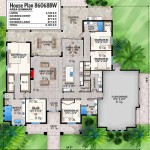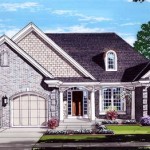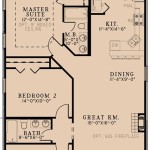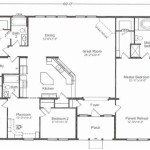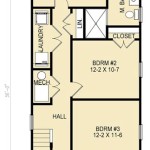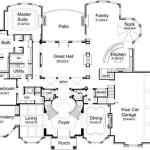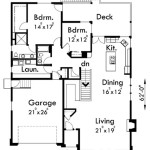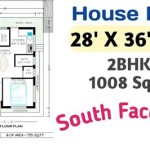Open Floor Plan House Designs: A Comprehensive Overview
Open floor plan house designs have become increasingly popular in modern residential architecture. This design concept centers on minimizing the use of walls to delineate distinct rooms, instead creating large, interconnected spaces that foster a sense of spaciousness and flow. While offering numerous benefits, open floor plans also present certain challenges that must be carefully considered during the design and construction phases.
This article will explore the key characteristics, advantages, and disadvantages of open floor plan house designs. Furthermore, it will delve into the various design considerations and practical applications of this architectural style, providing a comprehensive understanding of its functionality and appeal.
Defining Open Floor Plan Architecture
The core principle of an open floor plan is the removal of non-load-bearing walls to combine multiple functional areas into a single, larger space. Typically, this involves merging the kitchen, living room, and dining area into one expansive zone. The goal is to create a more social and interactive environment, enhancing natural light penetration and improving overall circulation within the home. The degree of openness can vary, ranging from a completely open space to a semi-open design that utilizes partial walls, columns, or changes in flooring to subtly define different areas.
The elimination of walls not only alters the physical layout but also influences the visual perception of the space. An open floor plan tends to appear larger and more airy compared to houses with traditional, compartmentalized rooms. This sense of spaciousness is particularly appealing in smaller homes, where it can help to maximize the perceived square footage. However, even in larger homes, open floor plans can create a more inviting and communal atmosphere.
In practical terms, creating an open floor plan requires careful consideration of structural integrity. Load-bearing walls, which play a crucial role in supporting the weight of the building, cannot be simply removed. If an open design necessitates the removal of a load-bearing wall, alternative structural solutions, such as the installation of beams or columns, must be implemented. This often requires the expertise of a structural engineer to ensure the safety and stability of the building.
Advantages of Open Floor Plan Designs
One of the primary benefits of an open floor plan is its ability to promote social interaction. By creating a large, shared space, it encourages family members and guests to engage with each other more freely. This is particularly advantageous for families with young children, as parents can easily supervise their children while preparing meals or performing other tasks. Similarly, open floor plans are ideal for entertaining, as they allow hosts to interact with guests while simultaneously managing food and beverages.
Enhanced natural light is another significant advantage. With fewer walls obstructing the flow of light, natural illumination can penetrate deeper into the home, reducing the need for artificial lighting. This not only saves energy but also creates a more pleasant and uplifting living environment. The abundant natural light can also enhance the visual appeal of the interior, making colors appear more vibrant and highlighting architectural details.
Furthermore, open floor plans offer increased flexibility in terms of furniture arrangement and space utilization. Without the constraints of walls, homeowners have greater freedom to customize the layout of their living areas to suit their specific needs and preferences. This flexibility also allows for future modifications, as the open space can be easily reconfigured to accommodate changing lifestyle requirements. For example, a portion of the living area could be transformed into a home office or a play area as needed.
Resale value can also be positively impacted by an open floor plan, as the design is highly sought after by many homebuyers. The modern aesthetic and the perceived spaciousness can make a home more appealing to potential buyers, potentially increasing its market value.
Disadvantages and Considerations
Despite the numerous advantages, open floor plans also present certain challenges. Noise control is a major concern. Without walls to buffer sound, noise can travel freely throughout the entire space. This can be particularly problematic in households with multiple occupants, as activities in one area can easily disrupt those in another. Strategies for mitigating noise pollution include the use of sound-absorbing materials, such as rugs, curtains, and upholstered furniture, as well as the strategic placement of appliances and entertainment systems.
A lack of privacy is another potential drawback. The open layout can make it difficult to find a quiet, secluded space for reading, working, or simply relaxing. This can be especially challenging for individuals who value their personal space or who need to concentrate on tasks requiring focus. Solutions for addressing this issue include the incorporation of designated quiet zones, such as home offices or reading nooks, separated from the main living area by partial walls or screens.
Heating and cooling can also be more complex in an open floor plan. The large, interconnected space requires a more efficient HVAC system to ensure even temperature distribution. Without walls to compartmentalize the air, it can be difficult to maintain consistent temperatures in different areas of the home. Zoning the HVAC system, which allows for separate temperature control in different zones, can help to address this issue. Additionally, the use of ceiling fans and strategically placed windows can improve air circulation and reduce energy consumption.
Maintaining cleanliness and organization is also crucial in an open floor plan. Because the space is so visible, clutter and messes can quickly become overwhelming. Regular cleaning and decluttering are essential to prevent the space from feeling chaotic and uninviting. Investing in storage solutions, such as built-in cabinets and shelving, can also help to keep the space organized and tidy.
Odor control is another important consideration, particularly in the kitchen area. Cooking odors can easily spread throughout the entire open space, which can be unpleasant for those in the living room or dining area. Installing a powerful range hood can help to vent cooking odors outside, and the use of air purifiers can further improve air quality. Additionally, choosing materials that are resistant to odors, such as stainless steel and solid surface countertops, can help to minimize the absorption of smells.
Finally, the cost of construction can be higher for an open floor plan, particularly if it involves the removal of load-bearing walls. The installation of alternative structural supports, such as beams and columns, can add to the overall construction costs. Additionally, the need for a more efficient HVAC system and specialized lighting can also increase the budget. Careful planning and budgeting are essential to ensure that the project remains within financial constraints.
Design Considerations for Open Floor Plans
Successfully implementing an open floor plan requires careful planning and attention to detail. Defining distinct zones within the open space is crucial for creating a sense of order and functionality. This can be achieved through the use of area rugs, furniture groupings, changes in flooring material, or the strategic placement of lighting fixtures. Each zone should have a clear purpose and be furnished accordingly.
Furniture selection plays a significant role in defining the space and creating visual separation. Large pieces of furniture, such as sofas and bookshelves, can be used to delineate different areas without completely blocking the flow of light or movement. The arrangement of furniture should also encourage conversation and interaction while maintaining a sense of openness.
Lighting is another key element in open floor plan design. A combination of ambient, task, and accent lighting can be used to create a layered effect that enhances the visual appeal of the space and highlights specific features. Recessed lighting can provide general illumination, while pendant lights can add a touch of style and define specific zones, such as the dining area. Task lighting, such as under-cabinet lights in the kitchen, can improve functionality and safety.
Color palettes should be carefully considered to create a cohesive and harmonious look throughout the open space. Using a consistent color scheme, with variations in tone and texture, can help to tie the different areas together and create a sense of unity. Introducing pops of color through accessories and artwork can add visual interest and personality.
Acoustic considerations are also essential for creating a comfortable and functional living environment. Incorporating sound-absorbing materials, such as rugs, curtains, and acoustic panels, can help to reduce noise levels and improve the overall sound quality. Strategically placing soft furnishings, such as upholstered furniture and pillows, can also help to absorb sound and create a more pleasant acoustic environment.
Finally, the incorporation of natural elements, such as plants and natural light, can enhance the sense of spaciousness and create a more inviting atmosphere. Plants can help to purify the air and add a touch of greenery, while natural light can brighten the space and improve overall well-being. The strategic placement of windows and skylights can maximize natural light penetration and create a connection to the outdoors.

Free Editable Open Floor Plans Edrawmax

Classic House Plans Open Floor Concept

10 Small House Plans With Open Floor Blog Homeplans Com

Open Floor Plans Build A Home With Smart Layout Blog Dreamhomesource Com
:max_bytes(150000):strip_icc()/1660-Union-Church-Rd-Watkinsville-Ga-Real-Estate-Photography-Mouve-Media-Web-9-77b64e3a6fde4361833f0234ba491e29.jpg?strip=all)
18 Open Floor House Plans Built For Entertaining

Modern Open Floor House Plans Blog Eplans Com

House Design Trends What S Popular In Cur Floor Plans Extra Space Storage

Open Floor Plans Creating A Breathable Livable Custom Home Builders Schumacher Homes

Free Editable Open Floor Plans Edrawmax

Pros And Cons Of An Open Concept Floor Plan Generation Homes Nw

